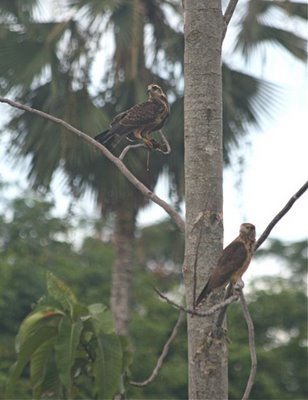 A view of two common raptors: yellow-headed caracara (lower) and snail kite (upper)--this one holding its drippy prey.
A view of two common raptors: yellow-headed caracara (lower) and snail kite (upper)--this one holding its drippy prey.While they're an endangered species, limited to peninsular Florida in the U.S., snail kites are really common along the Guyana coast, as is their prey, the apple snail, Pomacea paludosa. Snail kites sit all over the wires in Georgetown. We had a rare opportunity to watch a young bird working on its catch just across a canal. Snail kites are not plunge-divers; they neatly pluck snails from shallow water, usually without so much as wetting their belly feathers. If a snail kite can't find snails, as in a drought, it will take small mammals, turtles, fish and crabs, but the lion's share of its nutrition comes from apple snails.
The snail kite has a very specialized bill, with a sickle-shaped maxilla that it uses to pry the apple snail's body out of its protective shell. First, though, it must pry off the operculum, the snail's hard front door.
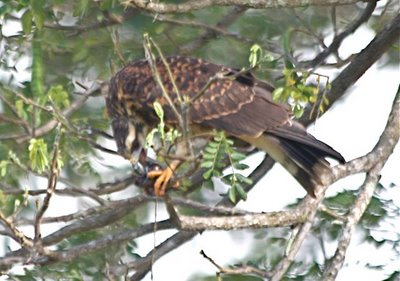 It sticks its maxilla tip in and cuts the columellar muscle, leaving the snail's body free to be removed. You can see here that the bird's bill is wide open as it runs the sickle-shaped maxilla deep into the shell to cut the muscle.
It sticks its maxilla tip in and cuts the columellar muscle, leaving the snail's body free to be removed. You can see here that the bird's bill is wide open as it runs the sickle-shaped maxilla deep into the shell to cut the muscle.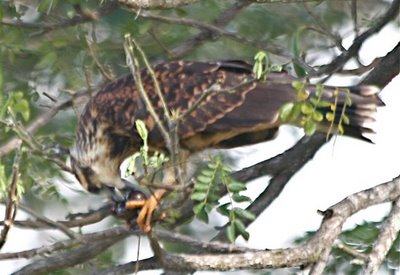 Then it pulls the whole protein-rich wad of meat out.
Then it pulls the whole protein-rich wad of meat out. 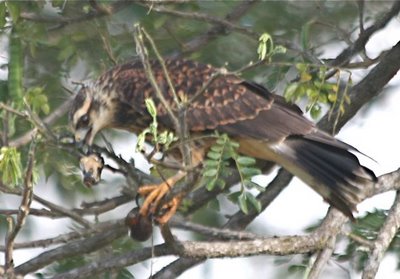 It removes what it doesn't want and gulps the rest down.
It removes what it doesn't want and gulps the rest down.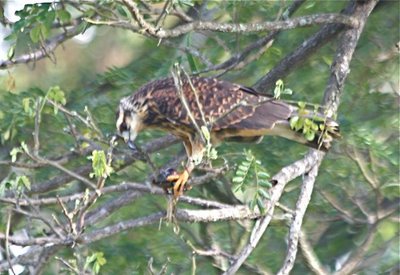
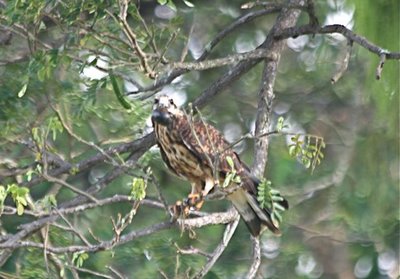 I got two acceptable kite shots. This is one of them. It's the same bird, closer and in better light.
I got two acceptable kite shots. This is one of them. It's the same bird, closer and in better light.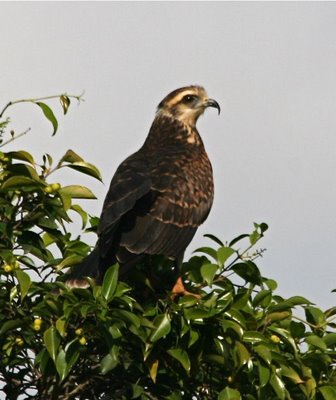
And here's a lovely adult, all slate-gray with a white and black banded tail, perched on a tangle of powerlines near the Georgetown airport.
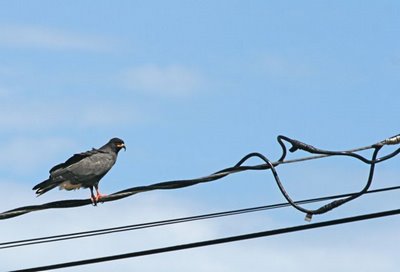 For really good photos of the same birds, see my friend Mike Weedon's beautiful photoblog, and my friend Kevin Loughlin's gorgeous web site. Mike was mostly digiscoping, and Kevin was hauling a big photorig and knew how to use it. This was the trip in which I discovered that I was underequipped for the things I wanted to shoot. I suspect it will be a recurring theme in posts to come. I'll try not to whine too much. This blog, after all, is supposed to be a celebration. Whee!
For really good photos of the same birds, see my friend Mike Weedon's beautiful photoblog, and my friend Kevin Loughlin's gorgeous web site. Mike was mostly digiscoping, and Kevin was hauling a big photorig and knew how to use it. This was the trip in which I discovered that I was underequipped for the things I wanted to shoot. I suspect it will be a recurring theme in posts to come. I'll try not to whine too much. This blog, after all, is supposed to be a celebration. Whee!






10 comments:
Amazing photographs and great capture of the snail meal. Gives new meaning to the word escargot! I am really enjoying these Guyana posts.
Oh, I'm in a swoon here.
Could be the cough syrup, but I think it's the kites.
I had high hopes for our trip to FL this summer, but no dice. Wonder how many snails it takes to keep a kite alive per day?
I think your photographs are awesome!
Whining is OK, Julie. What about those of us who whine about missing a shot of a backyard bird? OK?
Your photos SHOW US what birds do other than hang on suet feeders.
Amazing.
I'm loving these posts. Snail Kite - striking bird.
Mary
some of you may have read of the first-ever record of a snail kite in South Carolina last yr. which was observed by many imbibing on a steady diet of crawfish.
Thanks for that, Cyberthrush. I suppose a vagrant will eat whatever's there, but when you're used to escargot, mudbugs have to be a bit of a crunchy disappointment.
Thanks, too, for the kind words, Mel and Mary. I just want my photos to look like Mike's and Kevin's, (please do go see them, but come back!) I'm afraid that's not going to happen until I spend a whole lot more money and resign myself to walking around with a huge(r) wad of glass hanging off my shoulder.
WOW, what a bill! I'm with Susan... wonder how many snails they'll eat in a day?
Awright. I'm doin' the math for you girls.
If you look at the Birds of North America Snail Kite profile, you're not going to find anything as simple as the answer to "How many apple snails does a snail kite eat per day?"
You will find mean capture rates/foraging hour, and percentage of the day spent foraging. So:
Mean capture rate: 2.5 snails/hr
Percent of daylight hours spent foraging: 19
I'm figuring what? a 14 hour day?
So 19% of 14 hr. is 2.66 actual hours spent foraging. Multiply that times the mean of 2.5 snails/hr. and you get a rather surprising 6.6 snails/day. I'd have thought one or two would hold a kite all day, but upon further reading (and watching this bird) I realized that there's a lot of the snail that the bird discards, like digestive tract and narsty glands. So 6.6 morsels of snail meat per day, even given the size of the snail, doesn't seem all that outrageous, if it's even correct.
Science Chimp, signing off.
Oh, you did math. Yuk.
Thanx, Chimp. We obviously needed someone to step up and calculate.
: )
Post a Comment